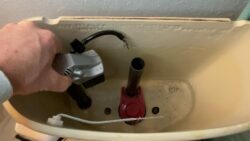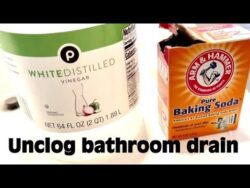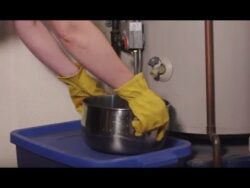In the world of plumbing, PVC pipes are a popular choice due to their durability and versatility. However, they are not immune to wear and tear, and the need for patching and repairing may arise. Whether it’s a small crack or a significant damage, knowing how to effectively patch and repair PVC pipes is essential to maintaining a functional plumbing system. This comprehensive guide aims to provide you with the necessary knowledge and step-by-step instructions to easily patch and repair PVC pipe, ensuring the longevity and efficiency of your plumbing infrastructure.
Overview
PVC pipe is widely used in plumbing and irrigation systems due to its durability, affordability, and easy installation. However, like any other material, PVC pipe can experience issues such as leaks, cracks, and joint failures. In this comprehensive guide, we will explore the necessary tools and materials for patching and repairing PVC pipe, as well as the importance of addressing these issues promptly. By understanding the techniques and safety precautions involved in PVC pipe repair, you will be equipped to handle common problems effectively and prevent future damage.
Understanding PVC Pipe
PVC pipe, or polyvinyl chloride pipe, is a lightweight and versatile material commonly used for various purposes, including water distribution, drainage, and irrigation systems. It is highly resistant to corrosion, chemicals, and UV rays, making it an ideal choice for both indoor and outdoor applications. PVC pipe comes in various sizes and can be easily connected using fittings and solvent cement. However, it is important to note that PVC pipe is not designed for high-temperature applications and may become brittle under extreme cold conditions.
Common Issues with PVC Pipe
While PVC pipe is known for its durability, it can still experience a range of common issues that require immediate attention. One of the most common problems is leaks, which can occur due to damaged fittings or small cracks in the pipe. Cracks, holes, and joint failures are also issues that may arise, compromising the efficiency of the plumbing or irrigation system. Additionally, improper installation techniques, exposure to extreme temperatures, and excessive pressure or stress can contribute to the deterioration of PVC pipe.
Importance of Patching and Repairing PVC Pipe
Promptly addressing issues with PVC pipe is crucial to prevent further damage and costly repairs. Ignoring small leaks or cracks can lead to larger problems, including burst pipes and extensive water damage. When left untreated, these issues can jeopardize the integrity of the entire plumbing system and result in significant repair expenses. By patching and repairing PVC pipe as soon as issues are detected, you can extend the lifespan of the system, ensure proper functionality, and minimize the risk of water damage and associated complications.
Tools and Materials
Before embarking on patching and repairing PVC pipe, it is important to gather the necessary tools and materials. Having the right equipment will ensure a successful repair and save you time and effort in the process. Here are the essential tools and recommended materials you will need:
Essential Tools for Patching and Repairing PVC Pipe
- PVC pipe cutter: A reliable pipe cutter will enable you to make precise cuts for removing damaged sections and installing replacements.
- Sandpaper or emery cloth: These abrasives are used to smooth the surface of the PVC pipe, ensuring proper adhesion during patching and repair.
- Adjustable wrenches or pliers: These tools are essential for loosening and tightening fittings, as well as securing repair couplings and compression fittings.
- Utility knife: A sharp utility knife is necessary for cutting and trimming epoxy putty or rubber repair sleeves, facilitating a secure and tight fit.
- Measuring tape: Accurate measurements are crucial when cutting replacement sections, as even small deviations can affect the overall fit and functionality of the repaired pipe.
Recommended Materials for Patching and Repairing PVC Pipe
- PVC patching compound: This specialized compound is designed to seal small leaks and cracks effectively, providing a waterproof and durable repair.
- Pipe wraps: These self-adhesive wraps are ideal for temporarily fixing minor leaks and offer a quick and easy solution until a permanent repair can be made.
- PVC repair couplings: Repair couplings are used to join two sections of PVC pipe, sealing cracks and restoring the pipe’s structural integrity.
- Epoxy putty: Epoxy putty is a versatile and long-lasting material that can be used to repair cracks and holes in PVC pipe by creating a strong and permanent bond.
- Compression couplings: Compression couplings are specifically designed to repair larger cracks and holes in PVC pipe, providing a tight and secure seal.
- Rubber repair sleeves: These sleeves are a reliable solution for patching and reinforcing damaged sections of PVC pipe, offering flexibility and durability.
Assessment and Preparation
Before starting the repair process, it is essential to assess the extent of the damage and properly prepare the damaged area. This step will ensure that the repair is effective and long-lasting. Here are the steps involved in assessing and preparing the PVC pipe for patching and repairing.
Inspecting the PVC Pipe for Damage
Thoroughly examine the PVC pipe, paying close attention to joints, fittings, and areas where leaks or cracks are suspected. Look for signs of water damage, discoloration, or bulging, as these indicators often point to underlying issues. In some cases, there may be visible cracks or holes that are easily identifiable. Additionally, check the pipe for any signs of deterioration due to extreme temperatures or excessive stress.
Determining the Extent of the Damage
Once the pipe has been inspected, assess the extent of the damage to determine the appropriate repair method. Small leaks or minor cracks may only require a patching compound or pipe wrap, while larger cracks, holes, or joint failures may necessitate more extensive repairs, such as using repair couplings or replacing sections of the pipe. Accurately gauging the severity of the damage will guide your approach and ensure an effective and lasting repair.
Clean and Prepare the Damaged Area
Before applying any patching or repair materials, it is essential to clean and prepare the damaged area. Use a cloth or brush to remove any dirt, debris, or loose particles from the surface of the pipe. For optimal adhesion, lightly sand the area around the damaged section using sandpaper or emery cloth. This step creates a roughened surface that enhances the bond between the repair material and the PVC pipe. Ensure that the prepared area is dry and free from any moisture or contaminants before proceeding with the repair.
Patching and Repairing Small Leaks
Small leaks in PVC pipe can be easily repaired using various methods. These fixes are ideal for addressing minor leaks before they escalate into more significant problems. Here are the techniques commonly used for patching and repairing small leaks in PVC pipe.
Using PVC Patching Compound
PVC patching compound is an effective solution for sealing small leaks in PVC pipe. This specialized compound is designed to adhere to the pipe’s surface, creating a waterproof and long-lasting repair. To apply the patching compound, first, ensure that the damaged area is clean and dry. Then, using a putty knife or gloved fingers, spread the compound evenly over the leak, ensuring complete coverage. Allow the compound to dry as per the manufacturer’s instructions before testing the repair by running water through the pipe.
Applying Pipe Wraps
Pipe wraps are an easy-to-use and quick solution for temporarily stopping minor leaks in PVC pipe. These self-adhesive wraps are made from a composite material that provides an immediate fix until a permanent repair can be made. To use a pipe wrap, first, ensure that the damaged area is clean and dry. Simply wrap the adhesive tape tightly around the leak, starting from a few inches before the leak and extending a few inches beyond it. Firmly press the wrap against the pipe to ensure a secure seal.
Utilizing PVC Repair Couplings
PVC repair couplings are commonly used to join two sections of PVC pipe and are an effective solution for repairing small leaks or cracks. To utilize a repair coupling, start by cutting out the damaged section of the pipe using a PVC pipe cutter. Ensure that the cut is clean and straight for a proper fit. Slide the repair coupling onto one end of the cut pipe and insert the other end of the pipe into the opposite side of the coupling. Tighten the clamps or screws on the repair coupling using adjustable wrenches or pliers until a secure and watertight connection is achieved.
Using Epoxy Putty
Epoxy putty is a versatile repair material that can be used to fix minor cracks and holes in PVC pipe. This two-part adhesive forms a strong and permanent bond, creating a durable and watertight repair. To use epoxy putty, first, knead the two parts together until they form a uniform color. Apply the putty directly onto the crack or hole, ensuring complete coverage and pressing it firmly against the pipe. Smooth the putty with a damp cloth or gloved fingers to blend it with the pipe’s surface. Allow the putty to cure as specified by the manufacturer before testing the repair.
Repairing Cracks and Holes
Cracks and holes in PVC pipe require more extensive repairs to maintain the integrity of the plumbing or irrigation system. Here are the steps involved in repairing cracks and holes of different sizes in PVC pipe.
Identifying Cracks and Holes in PVC Pipe
Inspect the PVC pipe carefully to identify any cracks or holes that may be present. Cracks can occur due to age, stress, or freezing temperatures, while holes may result from physical damage or improper installation techniques. Make sure to assess the size and severity of the crack or hole, as this will determine the appropriate repair method.
Patching Small Cracks
Small cracks can be repaired using PVC patching compound or epoxy putty. For cracks smaller than 1/4 inch in width, PVC patching compound provides an effective solution. Follow the instructions provided by the manufacturer to apply the patching compound over the crack, ensuring that it completely covers the damaged area. Allow the compound to dry before testing the repair. Alternatively, epoxy putty can be used for minor cracks. Knead the putty together and apply it directly onto the crack, smoothing it out to create an even surface. Allow the putty to cure before testing the repair.
Using Compression Couplings for Larger Cracks and Holes
Larger cracks and holes may require the use of compression couplings for a secure and watertight seal. Begin by cutting out the damaged section of the pipe using a PVC pipe cutter. Ensure that the cut is clean and straight to facilitate proper connection with the compression coupling. Slide the compression coupling onto one end of the cut pipe and insert the other end into the opposite side of the coupling. Secure the coupling by tightening the clamps or screws using adjustable wrenches or pliers. Verify that the repair is tight and leak-free before restoring water flow through the pipe.
Using Rubber Repair Sleeves
Rubber repair sleeves are an excellent solution for patching and reinforcing larger cracks and holes in PVC pipe. These sleeves are flexible and provide a durable and watertight repair. To utilize a rubber repair sleeve, cut the sleeve to the appropriate length, allowing for a proper fit over the damaged section of the pipe. Apply adhesive or a rubber-friendly sealant to the inside of the sleeve and slide it over the damaged area, ensuring a snug fit. Press the sleeve firmly against the pipe to create a secure bond. Allow the adhesive to cure before testing the repair by running water through the pipe.
Replacing Broken Sections
In cases where the damage to the PVC pipe is extensive or irreparable, it may be necessary to replace the broken section entirely. Here is a step-by-step guide for replacing broken sections of PVC pipe.
Assessing the Need for Replacement
Evaluate the damage to determine whether the broken section of PVC pipe needs to be replaced. Look for signs of extensive cracking, severe deterioration, or physical damage that cannot be effectively repaired. If the damage is beyond repair or compromises the overall functionality of the pipe, replacement is the best course of action.
Removing the Damaged Section
To remove the damaged section of PVC pipe, start by cutting it out using a PVC pipe cutter. Make clean and straight cuts on both ends of the damaged section. Ensure that the cuts are perpendicular to the pipe to facilitate a proper fit during installation. Remove any burrs or rough edges from the cut ends using a utility knife or sandpaper.
Measuring and Cutting a New Section
Measure the length of the replacement section needed to fill the gap left by the removed piece. Use a measuring tape to obtain accurate measurements. Mark the measurement on the replacement pipe and make a straight cut using a PVC pipe cutter. Verify that the cut is clean and straight, as any deviations can affect the overall fit and functionality of the repaired section.
Installing the Replacement Section
Before installing the replacement section, ensure that the cut ends are clean and free from debris. Apply primer to the outside of the existing pipe and the inside of the replacement section. Similarly, apply solvent cement to both ends of the existing pipe and the inside of the replacement section. Insert the replacement section into one end of the existing pipe and hold it firmly for a few seconds to allow the solvent cement to bond. Repeat this process for the other end of the replacement section. Give the solvent cement sufficient time to cure before restoring water flow through the pipe.
Repairing Joints
Joints in PVC pipe can experience issues such as leaks, cracks, or weakening over time. Repairing joints requires specific techniques to ensure a reliable and long-lasting fix. Here is a guide on repairing common joint issues in PVC pipe.
Identifying Common Joint Issues
Examine the joints in the PVC pipe to identify any signs of leaks, cracks, or weakened connections. Leaks at joints can occur due to loose fittings, faulty solvent cement application, or degradation of the joint over time. Additionally, cracks may occur in joint fittings due to extreme temperatures or improper installation. Properly identifying the cause and extent of the joint issue will guide your approach to repair.
Using PVC Joint Repair Fittings
PVC joint repair fittings are designed specifically to fix joint issues in PVC pipe. These fittings provide a simple and effective solution for leaks, cracks, or weakened connections. To use a PVC joint repair fitting, start by cutting out the damaged section of the pipe using a PVC pipe cutter. Ensure that the cut is clean and straight for a proper fit with the repair fitting. Insert one end of the pipe into one side of the repair fitting and the other end into the opposite side. Tighten the clamps or screws on the repair fitting using adjustable wrenches or pliers until a secure and watertight connection is achieved.
Applying Solvent Cement
Applying solvent cement to joints is essential for ensuring a reliable and long-lasting repair. Solvent cement is a strong adhesive that creates a chemical bond, effectively joining PVC pipe and fittings. To apply solvent cement, start by cleaning the joint surfaces using a cloth or brush to remove any dirt or debris. Apply primer to the outside of the pipe and the inside of the fitting, taking care to cover the entire joint surface. Use a clean brush or applicator to spread solvent cement evenly on the primed surfaces. Insert and twist the pipe into the fitting, ensuring a secure connection. Allow the solvent cement to cure as per the manufacturer’s instructions before using the repaired joint.
Preventing Future Damage
While patching and repairing PVC pipe is crucial for addressing existing issues, implementing preventive measures can significantly reduce the likelihood of future damage. By following proper installation techniques, using primer and solvent cement correctly, protecting PVC pipe from extreme temperatures, and avoiding excessive pressure and stress, you can maintain the integrity and functionality of your plumbing or irrigation system.
Implementing Proper Installation Techniques
Proper installation techniques are key to preventing future damage to PVC pipe. Ensure that pipes are properly aligned and supported, allowing for expansion and contraction as necessary. Use the correct size and type of fittings for the specific application to ensure a proper and secure connection. Adhere to the recommended torque when tightening fittings to avoid damaging the pipe or creating stress points. Following these installation guidelines will minimize the risk of leaks, cracks, and joint failures.
Using Primer and Solvent Cement Correctly
When joining PVC pipe and fittings using solvent cement, it is imperative to use primer and cement correctly. Primer prepares the surfaces and enhances the adhesion of the solvent cement, ensuring a strong and durable bond. Apply primer to the outside of the pipe and the inside of the fitting before applying solvent cement. Use the appropriate cement for the specific type of PVC pipe and fittings being used. Follow the manufacturer’s instructions for both the primer and solvent cement, including curing times, to ensure a successful joint and prevent leaks or failures.
Protecting PVC Pipe from Extreme Temperatures
PVC pipe is sensitive to extreme temperatures, both hot and cold. Protecting PVC pipe from prolonged exposure to extreme temperatures can prevent damage and premature deterioration. Insulate pipes located in areas prone to freezing to avoid cracking or bursting during cold weather. Similarly, shield pipes from direct sunlight or intense heat sources to prevent warping or melting. By employing insulation and shading techniques, you can safeguard PVC pipe and maintain its integrity in various climates.
Avoiding Excessive Pressure and Stress
Excessive pressure and stress can cause PVC pipe to weaken, leading to leaks, cracks, or joint failures. Avoid subjecting PVC pipe to excessive water pressure by installing pressure regulators or reducing valves when necessary. Large temperature fluctuations can also create stress in PVC pipe, so taking measures to stabilize water temperatures can help prevent damage. Additionally, avoid placing heavy objects or applying excessive force on PVC pipe, as this can cause bending, twisting, or cracking.
Safety Precautions
When engaging in PVC pipe patching and repair, it is essential to prioritize safety. Adhering to safety precautions will minimize the risk of accidents, injuries, or exposure to hazardous substances. Here are some safety measures to consider:
Wearing Necessary Safety Gear
Always wear the appropriate safety gear when working with PVC pipe. This includes safety goggles or glasses to protect your eyes from debris or chemicals. Additionally, wearing gloves can prevent injury from sharp edges or contact with adhesives or solvent cement. Steel-toed boots or closed-toe shoes will protect your feet from potential accidents.
Working in Well-Ventilated Areas
Ensure that you are working in a well-ventilated area to prevent the buildup of potentially harmful fumes or gases. Open windows or use fans to enhance airflow and remove any airborne chemicals or particles. If working in an enclosed space, such as a crawl space or utility room, consider using a portable fan or wearing a respiratory mask for added protection.
Using Caution with Heat Sources
When using heat sources, such as torches or heat guns, exercise caution to prevent accidental fires or burns. Ensure that flammable materials are kept away from the work area. Follow proper safety guidelines for using heat sources and be mindful of your surroundings to prevent injury or property damage.
Avoiding Accidental Contact with Chemicals
PVC repair often involves the use of adhesives, primer, and solvent cement, which can be harmful if not handled properly. Keep these chemicals out of the reach of children and pets, and avoid direct contact with skin or eyes. Follow the manufacturer’s instructions for proper use, storage, and disposal of these substances. In case of accidental contact or ingestion, seek medical attention immediately.
Seeking Professional Help
While many PVC pipe repairs can be tackled as a DIY project, there are instances where professional help may be necessary. Identifying when to call a professional and choosing a reputable PVC pipe repair service are essential for complex or extensive repairs. Here are some considerations:
Knowing When to Call a Professional
If you are unsure about the extent of the damage, lack the necessary tools or expertise, or if the repair requires specialized knowledge or equipment, it is advisable to seek professional help. Professionals have the experience and skills to handle complex repairs, ensuring that the job is done correctly and efficiently. Additionally, if the repairs involve intricate plumbing or irrigation systems, involve high-pressure systems, or require permits or inspections, it is best to consult a professional to comply with regulations and ensure safety.
Choosing a Reputable PVC Pipe Repair Service
When selecting a PVC pipe repair service, it is important to choose a reputable and reliable provider. Research local companies and read reviews or testimonials to gauge their expertise and performance. Look for professionals who are licensed, insured, and experienced in PVC pipe repairs. Ensure that the company offers reasonable warranties or guarantees on their work to safeguard against potential issues in the future. Obtaining multiple quotes and comparing prices and services will help you make an informed decision.
Understanding the Cost of Professional Repairs
The cost of professional PVC pipe repairs will vary depending on the scope, complexity, and location of the damage. Factors such as the extent of the repair, accessibility of the pipe, labor costs, and any necessary permits or inspections can influence the overall cost. It is recommended to request a detailed estimate from the chosen professional, outlining the specific repairs, materials, and associated costs. This will allow you to budget accordingly and ensure that you are aware of the total expense before the work begins.
In conclusion, patching and repairing PVC pipe can be accomplished with the right tools, materials, and techniques. By understanding the common issues that can arise, conducting proper assessments, and following the necessary safety precautions, you can effectively address issues such as leaks, cracks, joint failures, and damaged sections. Whether opting for a DIY repair or seeking professional help, addressing PVC pipe issues promptly will prolong the lifespan of the system, ensure optimal functionality, and prevent water damage and associated complications.





